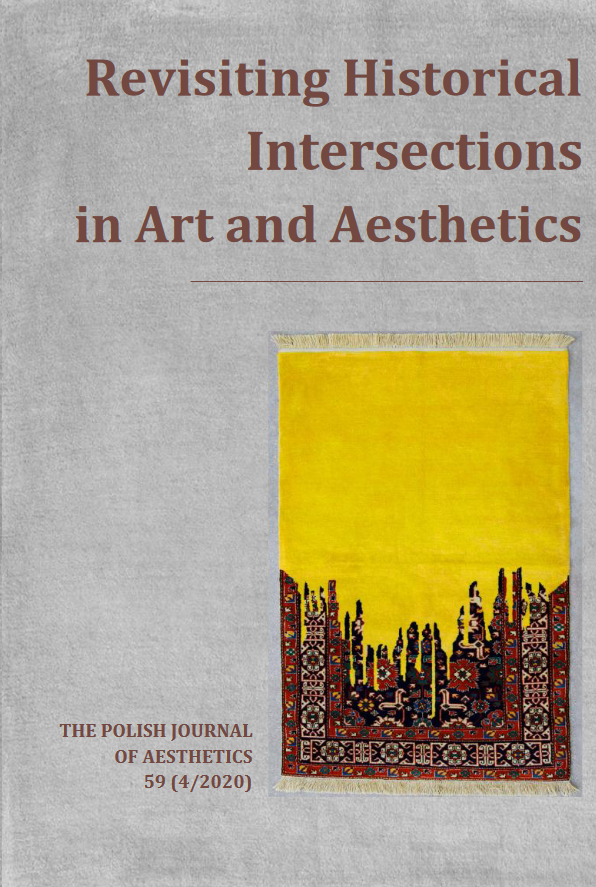Numer 59 (4/2020)
Revisiting Historical Intersections in Art and Aesthetics|
Spis treści
Strony
Pobierz
|
|||||
|
|
|||||
|
|
|||||
|
João Lemos
Restrictions, Incitements, and Aesthetic Value. The Role of Historical Sciences in Art Production and the Aesthetic Appreciation of Art
DOI: 10.19205/59.20.1
13 – 27
|
|||||
|
Słowa kluczowe Aesthetic Value |Adherent Beauty |Kant |History of Art |RulesStreszczenie This paper addresses the role played by historical sciences—their concepts, rules, and examples—in art production and the aesthetic appreciation of art. Based on Kant’s notion of ‘adherent beauty,’ and focusing on the case of ‘beautiful art,’ I will propose that historical sciences play a twofold role: not only do they work as restrictions when it comes to art production and appreciation, but they also function as enabling conditions and incitements for the disclosure of new rules and the ascription of aesthetic value to works of art. INFORMACJE O AUTORZE
Universidade Nova de Lisboa, Portugalia
|
|||||
|
Enea Bianchi
In Praise of a Strategic Beauty. Mario Perniola’s Aesthetics between Stoicism, the Baroque and the Avant-Gardes
DOI: 10.19205/59.20.2
29 – 42
|
|||||
|
Słowa kluczowe Mario Perniola |Stoicism |baroque |Avant-Gardes |Strategic BeautyStreszczenie Several scholars (Bartoloni 2019, Bukdahl 2017, Vogt 2019) focused on Mario Perniola’s perspective on art, post-human sexuality and political theory. Yet little has been written on the philosophical and literary sources—specifically Stoicism, the Baroque and the Avant-Gardes—which influenced his standpoint. The objective of this paper is to develop Perniola’s conception of a strategically oriented beauty, which implies a connection between the aesthetic element and the political-effectual one. INFORMACJE O AUTORZE
National University of Ireland
|
|||||
|
Lukáš Makky
(Re)construction, (Re)evaluation, or (Re)interpretation of the Past: What Happens When the Past Meets with the Present?
DOI: 10.19205/59.20.3
43 – 58
|
|||||
|
Słowa kluczowe Context |Archaeo-Context |Evaluation of the Past |Aesthetic Interpretation |possible worldsStreszczenie The image of the ancient past represents just a fragment. When we stand in front of such an image, we are standing in front of time. This text reflects the possibilities of aesthetic evaluation of ancient artifacts with the emphasis on the contextual perception of received phenomena. The defining concept of context is based on Jan Mukařovsky’s approach. The aim of the paper is also to present aesthetic interpretation as a regular method of verifying prehistoric artifacts. INFORMACJE O AUTORZE
Prešovská univerzita v Prešove, Słowacja
|
|||||
|
Judit Bartha
Olimpia Revisited. Variations on a Theme by E. T. A. Hoffmann in 20th Century Avant-Garde Art
DOI: 10.19205/59.20.4
59 – 76
|
|||||
|
Słowa kluczowe Romanticism |Gothic Fiction |Android |avant-garde |Fine ArtsStreszczenie The long reception of the doll Olimpia in E. T. A. Hoffmann’s The Sandmann represents the change of the ideologies concerning androids. The paper focuses on three transformations of the Romantic creature in 20th century Avant-garde art, namely, in works by Max Ernst, Oskar Schlemmer, and Cindy Sherman. It is aimed at showing how the machine myth of the 18th and 19th centuries, closely related to Gothic Romanticism, could become an important part of 20th century art. INFORMACJE O AUTORZE
Eötvös Loránd Tudományegyetem, Węgry
|
|||||
|
Zoltán Somhegyi
The Past as a Springboard for Understanding the Present. Classical Motifs in Contemporary Art through Examples from the MENA Region and Asia
DOI: 10.19205/59.20.5
77 – 91
|
|||||
|
Słowa kluczowe Past Forms in Contemporary Art |MENA Region and Asia |Carpet |Calligraphy |photographyStreszczenie The re-emergence of classical forms, motifs, and media in contemporary art is an exciting field of research. In this paper, through a series of case studies, I focus on carpets, calligraphy, and photography in the oeuvre of artists working in or originating from countries with a predominantly Muslim aesthetic heritage, to see how these novel pieces can contribute to our present understanding of aesthetics and thus a better understanding of our present. |
|||||
|
|
|||||

